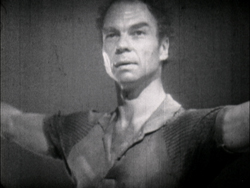Description
First composed and performed in 1965, Variations V is a true testament to 1960's experiments with "intermedia"—a coexistence and cutting across of artistic genres that profoundly informed Cunningham's choreographic practice. Video is materially integrated into the performance, with projections by Stan VanDerBeek and overlaid TV distortions by Nam June Paik enveloping the dancers. Twelve sound-sensitive electronic poles dot the stage; sound is triggered by the dancers' movements and then altered or delayed by the musicians. Variations V predates Cunningham's "video-dances," demonstrating a different moment in his relation to the technology.
A kind of explicit, corporeal engagement with video as medium is reflected in the performance's sound component. Sound, like video, exists in this dance visually and even kinetically. The viewer of this 1966 archival performance gains access to the locus of sound production, seeing John Cage and David Tudor perched over a wide spread of electronic equipment. Cunningham pays attention to the musicians' movements in his 1968 book Changes: Notes on Choreography, their "constant scuttling" moving "back and forth on the platform to fix things, wiring that came out, a plug, etc." The performance moves dialectically between its phenomenological whole and the "varied" elements of sound, video and dance that constitute it.
Unlike most of Cage and Cunningham's collaborations, sound and movement are more technically codependent than autonomous in Variations V. Cunningham writes in Changes, "John decided to find out if there might not be ways that sound could be affected by movement, and he and David Tudor proceeded to find out that there were."
The twelve five-foot high, antennae-like poles each have a four-foot spherical sound radius to produce sound as dancers enter it. To further "vary" the composition, each antenna produced a different sound. Billy Klüver of Bell Laboratories devised the second sound source, which entailed photo-electric cells at the bottom of the poles, which trigger sound as dancers' shadows interrupt their light source. Cunningham likens the process to doors opening at a supermarket in turn, deemphasizing the collaboration between dance and sound. He comments how "the dancers triggered a sound but the kind of a sound, how long it might be, or the POSSIBLE REPETITION OF IT WAS CONTROL-led by the musicians," with their oscillators, short-wave radios and tape recorders. Nevertheless, the composition for Variations V was written only after its first performance, the dancers' movement leaving an indelible imprint on the sound.
Cunningham's non-narrative, anti-psychological focus on "dance itself" imposes a relation of kinetic immediacy between the dancers and their environment. There is the actual documentation of the performance and then there is the video that constitutes the performance, which in itself varies in its approach. VanDerBeek and Paik use video differently in Variations V, while both providing backgrounds, and at times superimposed foregrounds, to the dancers' movement. VanDerBeek projects images sourced from popular culture alongside rehearsal footage of the dancers made in Cunningham's studio. In his montage, VanDerBeek sets up a comparison between Cunningham's dance and other socio-historical legacies of movement, including factory piecework, fishing, cartoons, women applying makeup and air travel. He historically contextualizes the dance by placing it outside of its kinetic immediacy as an image of movement among many. At the same time, VanDerBeek celebrates Cunningham's creative ability to move towards an unmediated movement and to operate in the moment. In his wave-like abstract TV distortions, Paik embraces the kinetic immediacy of Cunningham and Cage's compositions. Like the subjective remove Cunningham articulated through dance's movement, Paik saw his TV manipulations as, "NOT the expression of my personality, but merely PHYSICAL MUSIC," as he described to Charlotte Moorman in 1974. Whereas VanDerBeek complicates the dance's purely kinetic presence, Paik's videos upturn historical imagery in favor of iconoclasm.
While explicit invocations of Marcel Duchamp are seen in works such as Walkaround Time (1968), Cunningham subtly interweaves Duchampian themes into Variations V, through what he calls "non-dance" activities. In his 2000 article "The Readymade as Movement" for Res 38, dance professor and author Mark Franko conceptually links Cunningham's interest in pedestrian movement to the Duchampian readymade by arguing "that bodies in ordinary motion are dance readymades." Examples of "non-dance" activities in Variations V include Cunningham potting a large plant and having Carolyn Brown smash the pot, only to re-pot it. Barbara Lloyd puts a towel on her head and then performs a headstand as Gus Solomons rocks her body back and forth. Both the towel and pot had microphones attached to them, so that any movements would produce sound. Towards the end of the dance, the dancers pull out a spool of white thread to connect them. This gesture cites Duchamp's 1942 installation, Mile of String, in which he made an unwieldy web of string throughout a Surrealist painting exhibition restricting the movement of exhibition-goers. The dance ends as Cunningham rides a bicycle across the stage, putting back to use Duchamp's infamous first readymade.
Variations V is simultaneously an homage and revision to this modernist legacy, infused as it is with both the immediacy of movement and its conceptual tensions with video.
Choreography: Merce Cunningham. Director: Arne Arnbom. Music: John Cage, "Variations V." Distortion of TV images: Nam June Paik. Film images: Stan VanDerBeek. Produced by Studio Hamburg, Nordeutscher Rundfunk. Dancers: Merce Cunningham, Carolyn Brown, Barbara Lloyd, Sandra Neels, Albert Reid, Peter Saul, Gus Solomons jr.
Exhibition & Distribution Conditions
This is a video transfer of a work initially shot on film. This is best shown as a projection, to reflect the original medium.
Projection Installation Checklist & Guidelines

